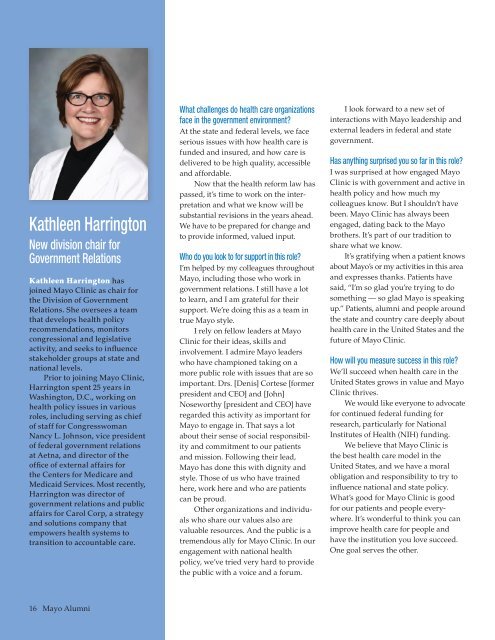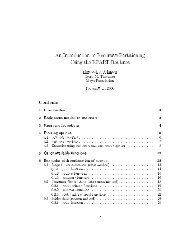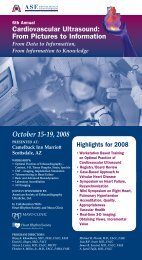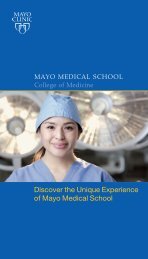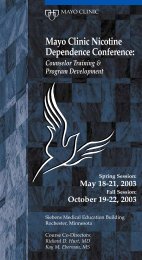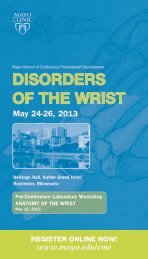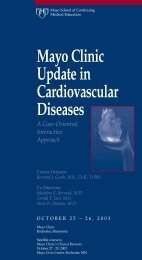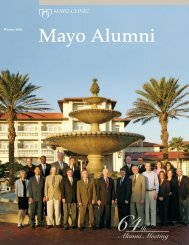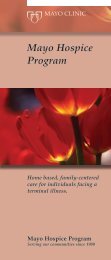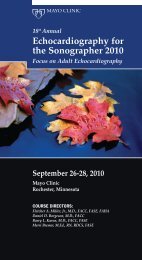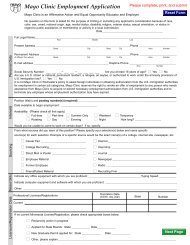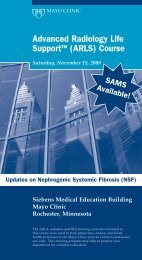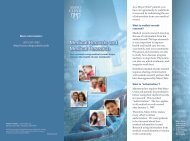Mayo Alumni Magazine 2011 Fall - MC4409-0811 - Mayo Clinic
Mayo Alumni Magazine 2011 Fall - MC4409-0811 - Mayo Clinic
Mayo Alumni Magazine 2011 Fall - MC4409-0811 - Mayo Clinic
Create successful ePaper yourself
Turn your PDF publications into a flip-book with our unique Google optimized e-Paper software.
kathleen harrington<br />
new division chair for<br />
Government relations<br />
Kathleen Harrington has<br />
joined <strong>Mayo</strong> <strong>Clinic</strong> as chair for<br />
the Division of Government<br />
Relations. She oversees a team<br />
that develops health policy<br />
recommendations, monitors<br />
congressional and legislative<br />
activity, and seeks to influence<br />
stakeholder groups at state and<br />
national levels.<br />
Prior to joining <strong>Mayo</strong> <strong>Clinic</strong>,<br />
Harrington spent 25 years in<br />
Washington, D.C., working on<br />
health policy issues in various<br />
roles, including serving as chief<br />
of staff for Congresswoman<br />
Nancy L. Johnson, vice president<br />
of federal government relations<br />
at Aetna, and director of the<br />
office of external affairs for<br />
the Centers for Medicare and<br />
Medicaid Services. Most recently,<br />
Harrington was director of<br />
government relations and public<br />
affairs for Carol Corp, a strategy<br />
and solutions company that<br />
empowers health systems to<br />
transition to accountable care.<br />
what challenges do health care organizations<br />
face in the government environment?<br />
At the state and federal levels, we face<br />
serious issues with how health care is<br />
funded and insured, and how care is<br />
delivered to be high quality, accessible<br />
and affordable.<br />
Now that the health reform law has<br />
passed, it’s time to work on the interpretation<br />
and what we know will be<br />
substantial revisions in the years ahead.<br />
We have to be prepared for change and<br />
to provide informed, valued input.<br />
who do you look to for support in this role?<br />
I’m helped by my colleagues throughout<br />
<strong>Mayo</strong>, including those who work in<br />
government relations. I still have a lot<br />
to learn, and I am grateful for their<br />
support. We’re doing this as a team in<br />
true <strong>Mayo</strong> style.<br />
I rely on fellow leaders at <strong>Mayo</strong><br />
<strong>Clinic</strong> for their ideas, skills and<br />
involvement. I admire <strong>Mayo</strong> leaders<br />
who have championed taking on a<br />
more public role with issues that are so<br />
important. Drs. [Denis] Cortese [former<br />
president and CEO] and [John]<br />
Noseworthy [president and CEO] have<br />
regarded this activity as important for<br />
<strong>Mayo</strong> to engage in. That says a lot<br />
about their sense of social responsibility<br />
and commitment to our patients<br />
and mission. Following their lead,<br />
<strong>Mayo</strong> has done this with dignity and<br />
style. Those of us who have trained<br />
here, work here and who are patients<br />
can be proud.<br />
Other organizations and individuals<br />
who share our values also are<br />
valuable resources. And the public is a<br />
tremendous ally for <strong>Mayo</strong> <strong>Clinic</strong>. In our<br />
engagement with national health<br />
policy, we’ve tried very hard to provide<br />
the public with a voice and a forum.<br />
I look forward to a new set of<br />
interactions with <strong>Mayo</strong> leadership and<br />
external leaders in federal and state<br />
government.<br />
has anything surprised you so far in this role?<br />
I was surprised at how engaged <strong>Mayo</strong><br />
<strong>Clinic</strong> is with government and active in<br />
health policy and how much my<br />
colleagues know. But I shouldn’t have<br />
been. <strong>Mayo</strong> <strong>Clinic</strong> has always been<br />
engaged, dating back to the <strong>Mayo</strong><br />
brothers. It’s part of our tradition to<br />
share what we know.<br />
It’s gratifying when a patient knows<br />
about <strong>Mayo</strong>’s or my activities in this area<br />
and expresses thanks. Patients have<br />
said, “I’m so glad you’re trying to do<br />
something — so glad <strong>Mayo</strong> is speaking<br />
up.” Patients, alumni and people around<br />
the state and country care deeply about<br />
health care in the United States and the<br />
future of <strong>Mayo</strong> <strong>Clinic</strong>.<br />
how will you measure success in this role?<br />
We’ll succeed when health care in the<br />
United States grows in value and <strong>Mayo</strong><br />
<strong>Clinic</strong> thrives.<br />
We would like everyone to advocate<br />
for continued federal funding for<br />
research, particularly for National<br />
Institutes of Health (NIH) funding.<br />
We believe that <strong>Mayo</strong> <strong>Clinic</strong> is<br />
the best health care model in the<br />
United States, and we have a moral<br />
obligation and responsibility to try to<br />
influence national and state policy.<br />
What’s good for <strong>Mayo</strong> <strong>Clinic</strong> is good<br />
for our patients and people everywhere.<br />
It’s wonderful to think you can<br />
improve health care for people and<br />
have the institution you love succeed.<br />
One goal serves the other.<br />
16 <strong>Mayo</strong> <strong>Alumni</strong>


